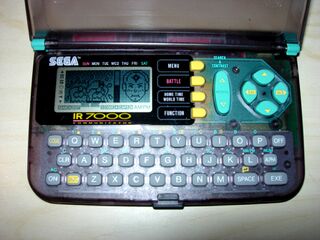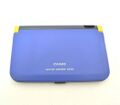Difference between revisions of "IR 7000 Communicator"
From Sega Retro
| Line 13: | Line 13: | ||
==Gallery== | ==Gallery== | ||
<gallery> | <gallery> | ||
| + | File:IR7000 US Unit.jpg | Sega IR 7000 Front | ||
File:IR7000 US Box Front.jpg |Package Front | File:IR7000 US Box Front.jpg |Package Front | ||
File:IR7000 US Box Inside.jpg |Package Inside | File:IR7000 US Box Inside.jpg |Package Inside | ||
| + | File:IR7000 US Box Inside.jpg |Package Inside Bottom | ||
File:IR7000 US Box Back.jpg |Package Back | File:IR7000 US Box Back.jpg |Package Back | ||
| + | File: SEGAIR7000-SIDE.jpg | Package Side | ||
</gallery> | </gallery> | ||
<gallery> | <gallery> | ||
Revision as of 16:24, 1 September 2018
This teeny-tiny article needs some work. You can help us by expanding it.
The IR 7000 Communicator is a handheld device manufactured by Casio and released by Sega to the United States in 1994. The IR 7000 acts as a personal digital assistant, and allows IR 7000 users to communicate with each other via an infra-red beam, referred to as a "Magic Beam" on the box and back of the device. The IR 7000 features include the ability to send text messages, play the one or two-player action game "Brain Drain", create pictures of contacts using 400 facial features, and save phone numbers and addresses with password protection. The device also features a scheduler, calendar, calculator, currency converter, alarm, memo pad, World map, and 10 language settings. The device retailed for $80.
The IR 7000 has much in common with the Casio Secret Sender 6000 (JD-6000) and the Casio My Super Magic Diary JD-6500, including similar button placements, shells, and modes. While not designated with a JD model number, it is likely that the IR 7000 is the successor to the JD-6500. While the IR 7000 has a battle mode, the JD-6000 has a universal television remote and the JD-6500 has a virtual pet. The IR 7000 does not feature Casio branding, however the default name for the owner of the device is "Casio".
Technical Specifications
- Memory: 128 KB
- Power source: Two AAA batteries and one CR2032 battery
- Display: LCD (Passive, Monochrome)
Gallery
Promotional material
also published in:
- Sega Visions (US) #21: "October/November 1994" (1994-xx-xx)[1]
- Sega Visions (US) #22: "December/January 1994/1995" (1994-xx-xx)[2]












